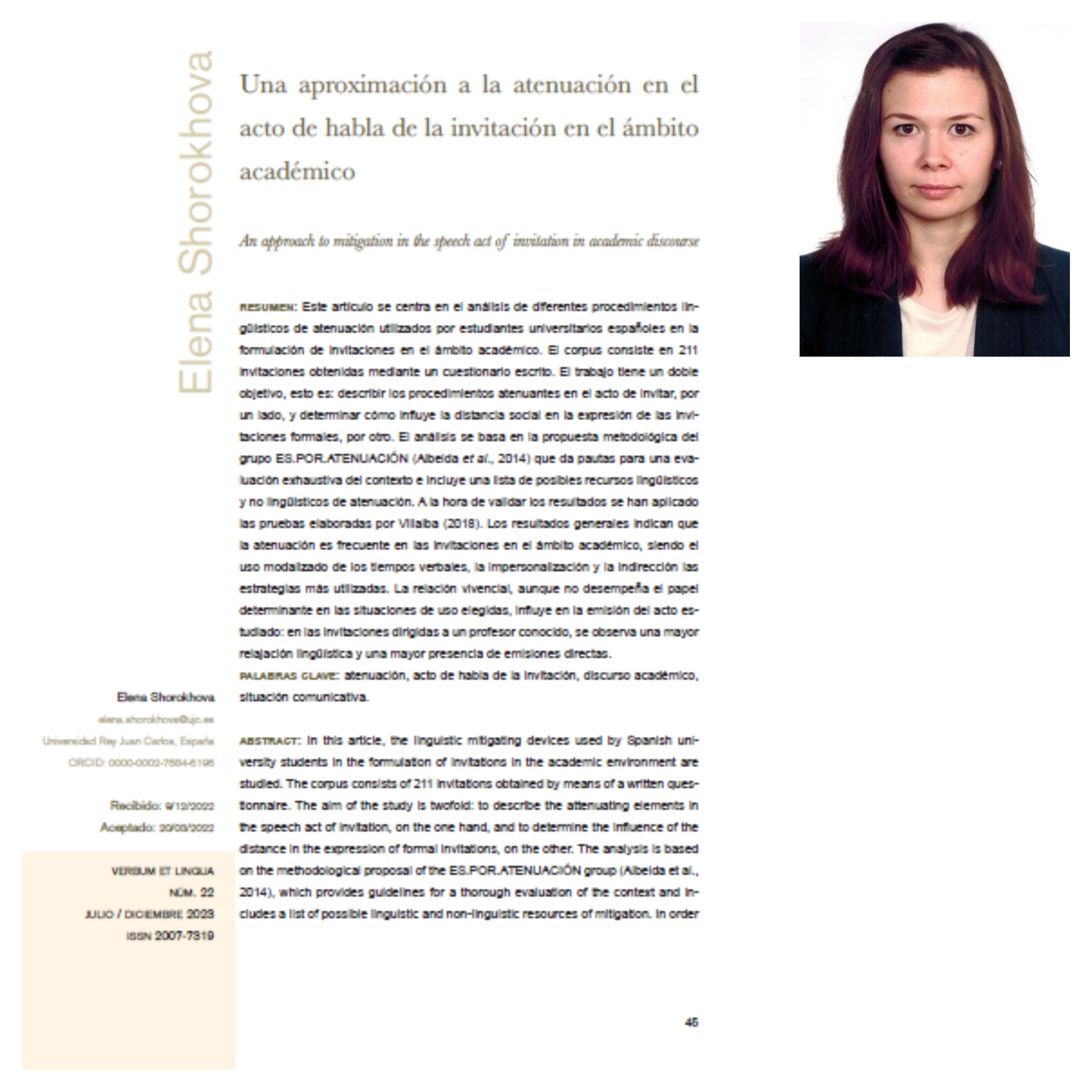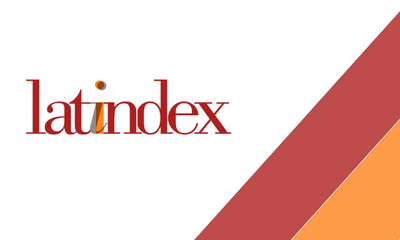An approach to mitigation in the speech act of invitation in academic discourse
DOI:
https://doi.org/10.32870/vel.vi22.209Keywords:
speech act of invitation, academic discourse, communicative situation, mitigationAbstract
In this article, the linguistic mitigating devices used by Spanish university students in the formulation of invitations in the academic environment are studied. The corpus consists of 211 invitations obtained by means of a written questionnaire. The aim of the study is twofold: to describe the attenuating elements in the speech act of invitation, on the one hand, and to determine the influence of the distance in the expression of formal invitations, on the other. The analysis is based on the methodological proposal of the ES.POR.ATENUACIÓN group (Albelda et al., 2014), which provides guidelines for a thorough evaluation of the context and includes a list of possible linguistic and non-linguistic resources of attenuation. In order to validate the results, the tests developed by Villalba (2018) have been applied. The overall results indicate that attenuation is frequent in academic invitations, with distancing in time introduced by manipulation of expression of tense, impersonalisation of the subject and indirectness being the most frequently used strategies. The distance, although it does not play the determining role in the chosen situations of use, influences the utterance of the analysed act: in the invitations addressed to a well-known professor, more relaxed language, and a greater presence of direct ways for making an invitation are observed.
Downloads
Metrics
References
Albelda Marco, M. (2016). Sobre la incidencia de la imagen en la atenuación pragmática. Revista Internacional De Lingüística Iberoamericana, 27, 19-32.
Albelda Marco, M., & Briz Gómez, A. (2020). Atenuación e intensificación. En M. V. Escandell Vidal, J. Amenós Pons & A. K. Ahern (Eds.), Pragmática (pp. 567-590). Madrid: Akal.
Albelda Marco, M., Briz Gómez, A., Cestero Mancera, A. M., Kotwica, D., & Villalba Ibáñez, C. (2014). Ficha metodológica para el análisis pragmático de la atenuación en corpus discursivos del español (ES.POR.ATENUACIÓN). Oralia: Análisis Del Discurso Oral, 17, 7-62. DOI: https://doi.org/10.25115/oralia.v17i.7999
Albelda Marco, M., & Estellés Arguedas, M. (2021). Mitigation revisited. An operative and integrated definition of the pragmatic concept, its strategic values, and its linguistic expression. Journal of Pragmatics, 183, 71-86. DOI: https://doi.org/10.1016/j.pragma.2021.07.002
Bardovi-Harlig, K. (2019). Invitations as request-for-service mitigators in academic discourse. Journal of Pragmatics, 139, 64-78. DOI: https://doi.org/10.1016/j.pragma.2018.10.005
Barros García, M. J. (2011). La cortesía valorizada en la conversación coloquial española: Estudio pragmalingüístico. Granada: Editorial Universidad de Granada.
Bella, S. (2009). Invitations and politeness in Greek: The age variable. Journal of Politeness Research, 5, 243-271. DOI: https://doi.org/10.1515/JPLR.2009.013
Briz Gómez, A. (2007). Para un análisis semántico, pragmático y sociopragmático de la cortesía atenuadora en España y América. LEA: Lingüística Española Actual, 29(1), 5-44.
Briz Gómez, A. (2018). La atenuación en la conversación coloquial. Una categoría pragmática. En A. Briz Gómez (Ed.), Al hilo del español hablado. reflexiones sobre pragmática y español coloquial (pp. 57-77). Sevilla: Editorial Universidad de Sevilla.
Briz Gómez, A., & Albelda Marco, M. (2013). Una propuesta teórica y metodológica para el análisis de la atenuación lingüística en español y portugués. La base de un proyecto en común (ES.POR.ATENUACIÓN). Onomázein, 28, 288-319. DOI: https://doi.org/10.7764/onomazein.28.21
Brown, P., & Levinson, S. C. (1987). Politeness. Some Universals in Language Usage. Cambridge: Cambridge University Press.
Caffi, C. (1999). On mitigation. Journal of Pragmatics, 31(7), 881-909. DOI: https://doi.org/10.1016/S0378-2166(98)00098-8
Caffi, C. (2007). Mitigation: A Pragmatic Approach. Amsterdam: Elsevier.
Cestero Mancera, A. M., & Albelda Marco, M. (2020). Estudio de variación en el uso de atenuación I: Hacia una descripción de patrones dialectales y sociolectales de la atenuación en español. Revista Signos. Estudios De Lingüística, 53(104), 935-961. DOI: http://dx.doi.org/10.4067/S0718-09342020000300935
Contreras Fernández, J., & Zhao, L. (2017). Análisis contrastivo de estrategias de atenuación en un corpus de correos electrónicos españoles, alemanes y chinos. En M. Albelda Marco & W. Mihatsch (Eds.), Atenuación e intensificación en diferentes géneros discursivos (pp. 205-220). Frankfurt am Main: Iberoamericana Vervuert.
De Latte, F., & Enghels, R. (2021). La variación lingüística del vocativo en el lenguaje juvenil madrileño. Revue Romane, 2(56), 177-204. DOI: https://doi.org/10.1075/rro.18011.del
Drew, P. (2018). Equivocal invitations (in English). Journal of Pragmatics, 125, 62-75. DOI: https://doi.org/10.1016/j.pragma.2017.07.005
Drew, P., & Couper-Kuhlen, E. (2014). Requesting – from speech act to recruitment. En P. Drew & E. Couper-Kuhlen (Eds.), Requesting in Social Interaction (pp. 1-34). Amsterdam / Philadelphia: John Benjamins.
Edeso Natalías, V. (2005). Usos discursivos del vocativo en español. Español Actual: Revista De Español Vivo, 84, 123-142.
Eslami, Z. R. (2005). Invitations in Persian and English: Ostensible or genuine? Intercultural Pragmatics, 2(4), 453-480. DOI: https://doi.org/10.1515/iprg.2005.2.4.453
Fraser, B. (1980). Conversational mitigation. Journal of Pragmatics, 4(4), 341-350. DOI: https://doi.org/10.1016/0378-2166(80)90029-6
Gancedo Ruiz, M. (2019). Evolución de la imagen de rol familiar en el teatro de finales del siglo XIX a mitad del XX. su manifestación en la atenuación e intensificación de los actos directivos. Valencia: Universidad de Valencia.
Garcés-Conejos Blitvich, P. (2013). Introduction: Face, identity and im/politeness. Looking backward, moving forward: From Goffman to practice theory. Journal of Politeness Research: Language, Behaviour, Culture, 9(1), 1-33. DOI: https://doi.org/10.1515/pr-2013-0001
García, C. (1999). The three stages of Venezuelan invitations and responses. Multilingua, 18(4), 391-433. DOI: https://doi.org/10.1515/mult.1999.18.4.391
Goffman, E. (1967). On face-work: An analysis of ritual elements in social interaction. En E. Goffman (Ed.), Interaction Ritual: Essays in Face-to-Face Behavior (pp. 5-45). New York: Doubleday.
Hancher, M. (1979). The Classification of Cooperative Illocutionary Acts. Language in Society, 8(1), 1-14. DOI: https://doi.org/10.1017/S0047404500005911
Haverkate, H. (1994). La cortesía verbal: Estudio pragmalingüístico. Madrid: Gredos.
Hernández Flores, N. (2013). Actividad de imagen: caracterización y tipología en la interacción comunicativa. Pragmática Sociocultural / Sociocultural Pragmatics, 1(2), 175-198. DOI: https://doi.org/10.1515/soprag-2012-0012
Hernández Toribio, M. I., & Mariottini, L. (2016). TripAdvisor y actos de habla. Delimitaciones teóricas y propuestas metodológicas para el análisis de las estrategias de atenuación de los actos directivo. Pragmática Sociocultural / Sociocultural Pragmatics, 4(2), 149-181. DOI: https://doi.org/10.1515/soprag-2016-0015
Isaacs, E. A., & Clack, H. H. (1990). Ostensible invitations. Language in Society, 19(4), 493-509. DOI: https://doi.org/10.1017/S0047404500014780
Lakoff, G. (1973). Hedges: A study in meaning criteria and the logic of fuzzy concepts. Journal of Philosophical Logic, 2, 458–508. DOI: https://doi.org/10.1007/BF00262952
Margutti, P., Tainio, L., Drew, P., & Traverso, V. (2018). Invitations and responses across different languages: Observations on the feasibility and relevance of a crosslinguistic comparative perspective on the study of actions. Journal of Pragmatics, 125, 52-61. DOI: https://doi.org/10.1016/j.pragma.2017.12.010
Routarinne, S., & Tainio, L. (2018). Sequence and turn design of invitations in Finnish telephone calls. Journal of Pragmatics, 125, 149-163. DOI: https://doi.org/10.1016/j.pragma.2017.05.001
Ruiz de Zarobe, L. (2001). Estrategias de invitación en español e imagen social de los hablantes: Un estudio empírico. Pragmalingüística, 8-9, 261-278. DOI: https://doi.org/10.25267/Pragmalinguistica.2017.i25
Ruiz de Zarobe, L. (2004). El acto de habla "invitación" en español y en francés: Análisis comparativo de la cortesía. Revista Española De Lingüística, 34(2), 421-454.
Sakamoto, A. (2020). La cortesía en la petición. Estudio contrastivo entre español y japonés. Valencia: Universidad de Valencia.
Schneider, S. (2017). Las dimensiones de la intensificación y de la atenuación. En M. Albelda Marco & W. Mihatsch (Eds.), Atenuación e intensificación en géneros discursivos (pp. 23-42). Frankfurt am Main: Iberoamericana Vervuert.
Searle, J. R. (1969). Speech Acts. Cambridge: Cambridge University Press.
Siebold, K. (2008). Actos de habla y cortesía verbal en español y en alemán. Frankfurt am Main: Peter Lang GmbH.
Thaler, V. (2012). Mitigation as modification of illocutionary force. Journal of Pragmatics, 44(6-7), 907-919. DOI: https://doi.org/10.1016/j.pragma.2012.04.001
Uclés Ramada, G. (2018). La atenuación de los marcadores de control
de contacto en PRESEEA: un estudio comparativo entre España y México. RILCE. Revista De Filología Hispánica, 34(3), 1313-35. DOI: https://doi.org/10.15581/008.34.3.1313-35
Villalba Ibáñez, C. (2018). Atenuación: Algunas claves metodológicas para su análisis. Normas, 8(1), 306-316. DOI: https://doi.org/10.7203/Normas.v8i1.13277
Villalba Ibáñez, C. (2020). Recognising mitigation: Three tests for its identification. Journal of Pragmatics, 167, 68-79. DOI: https://doi.org/10.1016/j.pragma.2020.06.015

Downloads
Published
Versions
- 2024-05-06 (2)
- 2023-07-01 (1)






